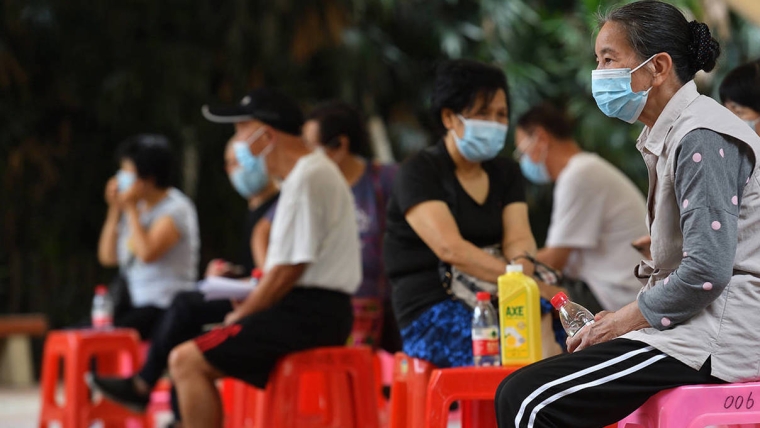
In March, Chinese Premier Li Qiang announced an ambitious economic growth target of 5% for 2024. In a subsequent commentary, former World Bank chief economist Justin Yifu Lin endorsed the government’s target, predicting that China’s economy will grow at an average annual rate of 5-6% over the coming decade before slowing to 3-4% between 2036 and 2050. Lin also suggested that China could achieve high-income status in 2026, if not 2025. Given China’s bleak demographic outlook, this seems highly unlikely.
Lin notes that 26 countries had less than half of the United States’ GDP per capita when their populations began to age. He argues that since these countries continued to improve their economies after this point, China can, too. The WHO defines the start of an economy’s aging phase as the point where the share of those aged 65 and older exceeds 7% – a demographic milestone China reached in 1998. By 2023, the share of Chinese people over 65 increased to 15.4%. [As at March 2024, New Zealand was at a record high 16.6%. The US, 17%. ] Historically, no country has managed to achieve 4% growth in the subsequent 12 years after the elderly made up 15% of the population. The average growth rate for high-income countries during this period is just 1.8%.
An aging population affects production, consumption, entrepreneurship, and innovation, eroding economic dynamism. As the median age and the share of people aged 65 and older increase, GDP growth slows. Consequently, Lin’s prediction that China will achieve an annual growth rate of 5-6% between 2024 and 2035 is as improbable as an 80-year-old winning a marathon.
Lin emphasises China’s latecomer advantage, but this is offset by its rapidly aging population. Demographic problems and shrinking labour forces have caused GDP per capita in Spain, Greece, and Portugal, respectively, to fall from 73%, 66%, and 51% of the US level in 2008 to 39%, 27%, and 32%. Along with other aging societies such as South Korea and Taiwan, these countries are now at risk of falling back into the middle-income trap.
China’s aging crisis is reminiscent of what happened in Japan and Germany, whose labour forces began to shrink in the mid-1990s. By 2023, Japan and Germany’s GDP per capita had fallen to 41% and 64% of the US level, respectively, from 154% and 110% in 1995.
Similarly, China’s median age in 2023 was the same as Japan’s in 1995 and Germany’s in 2000, while the share of people aged 65 and older matched Japan’s in 1996 and Germany’s in 1995. Over the 12 years that followed these demographic milestones, Japan’s average annual growth rate was 0.8%, and Germany’s was 1.4-1.5%. Based on these historical trends, China’s growth rate is likely to slow to 3% by 2028 and fall below that of the US from 2031 to 2035.
China’s GDP per capita reached US$12,681 in 2023, falling short of the World Bank’s high-income threshold of $13,845. With an average annual increase of 2.1% over the past two decades, the threshold is projected to rise to $15,715 by 2028 and $18,219 by 2035. Assuming that China’s per capita GDP growth slows from 5% in 2024 to 3% in 2028 and 1.5% in 2035, its GDP per capita is expected to reach $17,893 over the next decade. The widening economic gap between China and the US will further impede China’s ability to cross the high-income threshold.
Moreover, several factors are expected to put downward pressure on the renminbi, complicating China’s efforts to escape the middle-income trap. First, China’s labour force is shrinking rapidly, and its industrial value chain is shifting to countries participating in the government’s Belt and Road Initiative. Western countries’ attempts to reduce their dependency on Chinese supply chains could further weaken China’s manufacturing sector, eroding the country’s trade surplus.
Second, as economic growth slows and local governments grapple with an escalating debt crisis, Chinese interest rates are expected to fall.
Lastly, low fertility rates around the world could lead to low inflation and even outright deflation. China’s persistent low fertility rate, combined with insufficient domestic demand and excess capacity, is likely to intensify deflationary pressures, widening the interest-rate gap between the renminbi and the US dollar.
To be sure, if the high-income threshold were to remain unchanged, China might manage to reach it. But its aging population would likely prevent it from escaping the real middle-income trap. The country’s household disposable income accounts for only 42% of its GDP, well below the global average of 60-70%. The 2022 high-income threshold translates to per capita disposable income of $8,307-$9,692, typically indicative of a large middle class capable of exerting pressure on the government.
By contrast, China’s per capita disposable income was just US$5,565 in 2023, and its middle class remains a minority. To cross the high-income threshold, China would need to boost its GDP per capita to $19,000-22,000. But achieving this requires far-reaching reforms.
Above all, China must raise household disposable incomes and tackle its demographic crisis, both of which require a political and economic overhaul. Given that China today is even more averse to economic reforms than it was when Deng Xiaoping launched his market-oriented reforms in 1978, rapid change is highly unlikely. The required transformation may take several decades, if not longer.
*Yi Fuxian, a senior scientist in obstetrics and gynecology at the University of Wisconsin-Madison, is the author of Big Country with an Empty Nest. Copyright 2024 Project Syndicate, here with permission.
11 Comments
The direct outcome of the abhorrent, short-sighted single child policy
Bollocks.
Try getting yourself educated; https://donellameadows.org/archives/a-synopsis-limits-to-growth-the-30-…
or: https://www.thegreatsimplification.com/
The writer is perhaps influenced by his narrow discipline, but is way out of his depth, and way wrong. Wealth is 'per head', meaning less people is better. Only economics does its accounting as if the planet was infinite. Meaning only economics is chosenly-ignorant. Such a pity so many swallow that ignorance, lock stock and hogwash.
China's one-child policy was the best political leadership the world has seen, given the alternative is overshoot/collapse. You need to do some homework.
I agree with your economic analysis pdk...but the emotional harm they did to people is abhorent.
If we're going to reduce to 1-2 billion by century's end (and maybe much sooner - https://onlinelibrary.wiley.com/doi/full/10.1111/jiec.13442 ) then emotions are going to be harmed. Degree? I'd suggest China's way has the least angst - less than ignorantly-entered collapse.
Go well
I’l think you will find that China was already well on the way to a lower birthrate. They have scored an own goal as they can’t use immigration to resolve their demographic situation. I can’t think of a more human right than the choice if/when/how many children to have….
PDK must be ignorant of the fact countries, other than China, have lower birth rates without the abhorrent, anti human CCP policies. It is laughable he thinks this is the 'best political leadership" when other democratic countries, including New Zealand, have lower birth rates without the cruelty - then lectures other commenters to "try getting yourself educated"!
I don't know why people think China isn't seriously winning economically. Average wages have doubled in the last ten years and are not slowing down. https://tradingeconomics.com/china/wages
It's hard to take any stats out of China seriously. Shanghai families 'employ' their relatives for nothing but provide food/shelter as exchange for services, skewing results. Rural farmers and workers simply aren't on the books. I wouldn't be surprised if the average wage is actually half what it says. China is "Bigger than Beijing"
China’s GDP per capita reached US$12,681 in 2023, falling short of the World Bank’s high-income threshold of $13,845.
Lol. Just goes to show what a faulty metric GDP and GDP per capita is. GDP obviously does not correlate into real incomes. And how does a falling per capita GDP equal a lower standard of living? Sounds a lot like a fear based narrative that everyone wants to repeat without knowing how it actually manifests.
We're still yet to define what is a basic standard of living let alone a quality of living.
So everything is measured against US GDP and its a fail to not match? And it is most important that people keep breeding and overpopulating and killing our planet ? the ONLY important thing is growth by more people?
"China’s bleak demographic outlook"
"The current fertility rate for China in 2024 is 1.707 births per woman, a 0.12% increase from 2023."
Meanwhile is kiwiland -
"In the year ended March 2024 compared with the year ended March 2023 the total fertility rate was 1.52 births per woman, down from 1.65"
https://www.stats.govt.nz/information-releases/births-and-deaths-year-e…

We welcome your comments below. If you are not already registered, please register to comment
Remember we welcome robust, respectful and insightful debate. We don't welcome abusive or defamatory comments and will de-register those repeatedly making such comments. Our current comment policy is here.